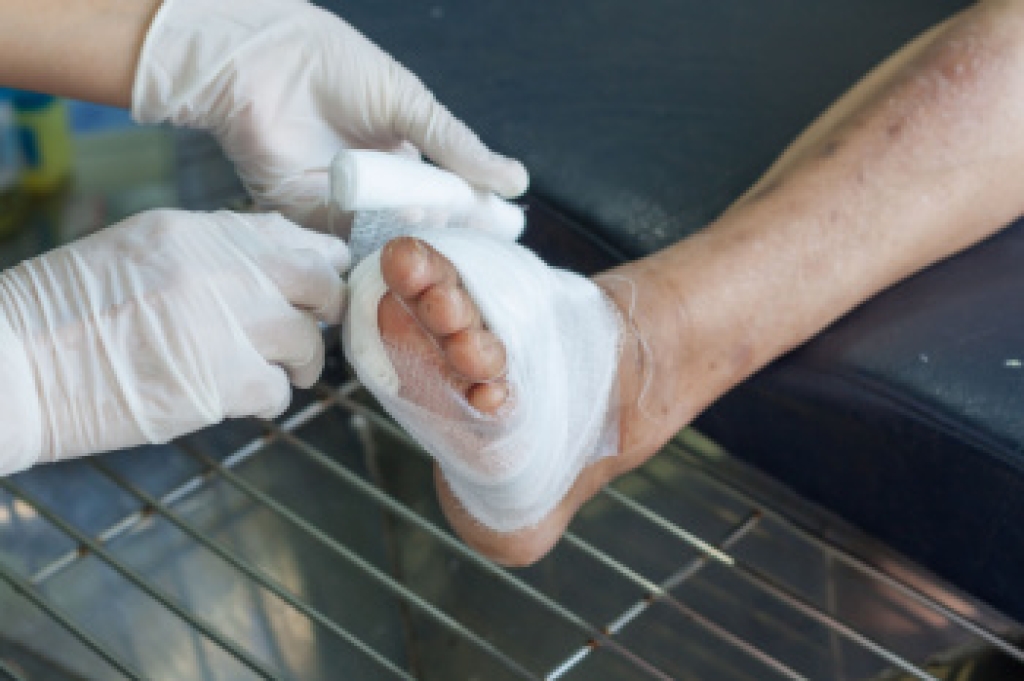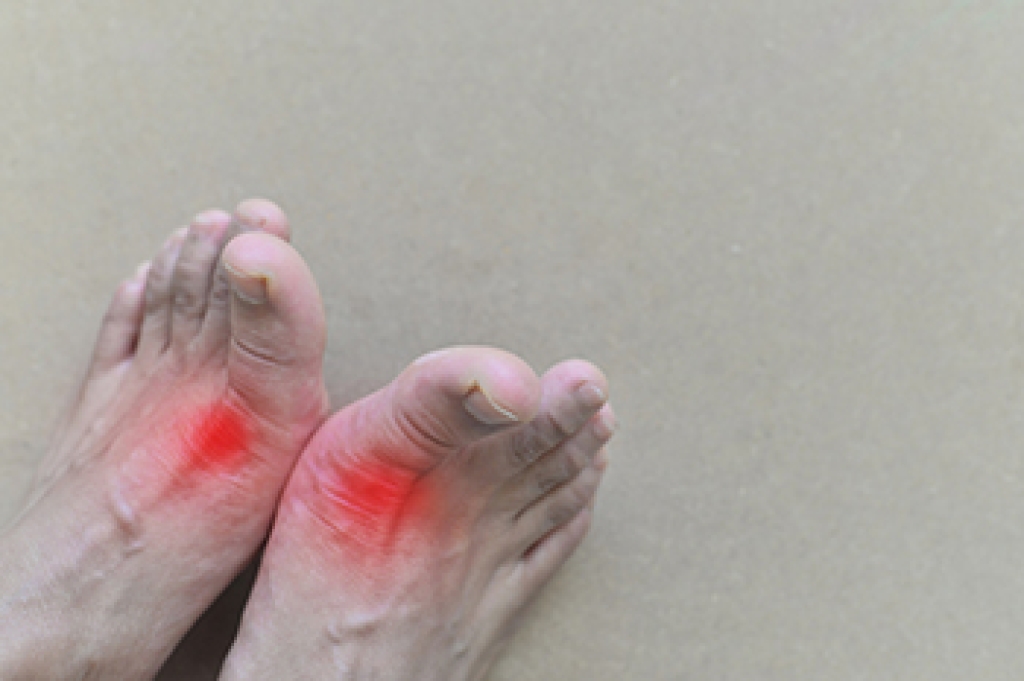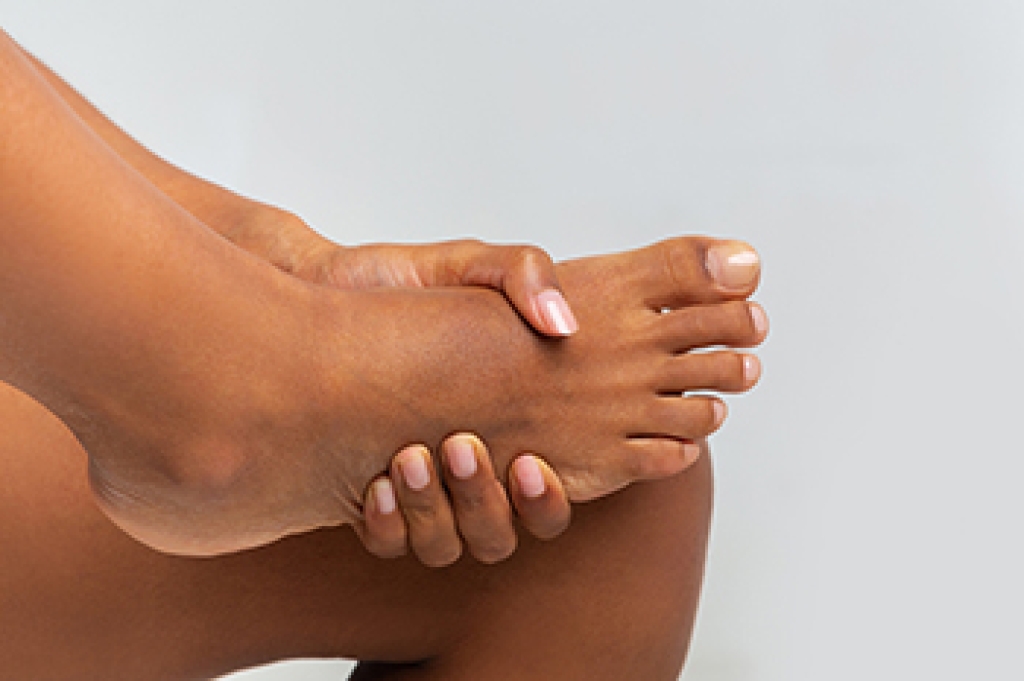Blog
Foot Problems Linked to Diabetes

Diabetes can affect the feet in many ways, often developing slowly and without obvious symptoms, at first. High blood sugar levels can damage nerves, leading to diabetic neuropathy, which causes numbness, tingling, burning, or loss of sensation. When you cannot feel pain or pressure normally, small injuries may go unnoticed and become more serious. Diabetes also affects circulation, reducing blood flow to the feet and making it harder for cuts, blisters, or sores to heal. Dry, cracked skin, thickened nails, calluses, and changes in foot shape can also occur as the disease progresses. One of the most serious complications is the development of foot ulcers, which can become infected, if not treated promptly. Regular foot checks, wearing proper footwear, and early intervention from a podiatrist can help prevent complications and protect long-term foot health. If you have diabetes, it is suggested that you see a podiatrist for foot checks on a regular basis.
Diabetic foot care is important in preventing foot ailments such as ulcers. If you are suffering from diabetes or have any other concerns about your feet, contact one of our podiatrists from Ocotillo Foot and Ankle Centers. Our doctors can provide the care you need to keep you pain-free and on your feet.
Diabetic Foot Care
Diabetes affects millions of people every year. The condition can damage blood vessels in many parts of the body, especially the feet. Because of this, taking care of your feet is essential if you have diabetes, and having a podiatrist help monitor your foot health is highly recommended.
The Importance of Caring for Your Feet
- Routinely inspect your feet for bruises or sores.
- Wear socks that fit your feet comfortably.
- Wear comfortable shoes that provide adequate support.
Patients with diabetes should have their doctor monitor their blood levels, as blood sugar levels play such a huge role in diabetic care. Monitoring these levels on a regular basis is highly advised.
It is always best to inform your healthcare professional of any concerns you may have regarding your feet, especially for diabetic patients. Early treatment and routine foot examinations are keys to maintaining proper health, especially because severe complications can arise if proper treatment is not applied.
If you have any questions, please feel free to contact our offices located in Chandler, and Phoenix, AZ . We offer the newest diagnostic and treatment technologies for all your foot care needs.
Children’s Intoeing Care

Children’s foot deformities are common and often noticed as a child begins to walk or becomes more active. Intoeing is a condition where the feet turn inward while walking, which may come from the hips, legs, or feet. Causes can include developmental changes, muscle imbalance, or inherited foot structure. Symptoms may involve frequent tripping, awkward walking patterns, uneven shoe wear, or leg fatigue during play. While many children outgrow intoeing, some cases may benefit from professional evaluation. A podiatrist can help by assessing gait, foot alignment, and growth patterns to determine the cause and severity. Treatment may include monitoring, stretching exercises, wearing supportive footwear, or custom orthotics to guide proper foot position. If you notice your child walking with their feet turned inward or having difficulty keeping up with activities, it is suggested that you schedule a podiatry consultation to ensure proper foot development and confident movement.
Making sure that your children maintain good foot health is very important as they grow. If you have any questions, contact one of our podiatrists of Ocotillo Foot and Ankle Centers. Our doctors can provide the care you need to keep you pain-free and on your feet.
Keeping Children's Feet Healthy
Having healthy feet during childhood can help prevent medical problems later in life, namely in the back and legs. As children grow, their feet require different types of care. Here are some things to consider...
Although babies do not walk yet, it is still very important to take care of their feet.
Avoid putting tight shoes or socks on his or her feet.
Allow the baby to stretch and kick his or her feet to feel comfortable.
As a toddler, kids are now on the move and begin to develop differently. At this age, toddlers are getting a feel for walking, so don’t be alarmed if your toddler is unsteady or ‘walks funny’.
As your child gets older, it is important to teach them how to take care of their feet.
Show them proper hygiene to prevent infections such as fungus.
Be watchful for any pain or injury.
Have all injuries checked by a doctor as soon as possible.
Comfortable, protective shoes should always be worn, especially at play.
If you have any questions, please feel free to contact our offices located in Chandler, and Phoenix, AZ . We offer the newest diagnostic and treatment technologies for all your foot care needs.
Understanding Gout and How a Podiatrist Can Help

Gout is a painful inflammatory condition that often strikes the big toe and can appear suddenly with intense redness, swelling, and warmth that makes even light contact uncomfortable. The attacks may feel like burning pressure or sharp throbbing, and the joint may look shiny or purple as uric acid crystals irritate the tissue. Gout is commonly caused by elevated uric acid levels linked to genetics, diet, certain medications, or underlying medical conditions. A podiatrist can assist from the very beginning by performing a careful examination, ordering appropriate tests, and distinguishing gout from other foot disorders. Early diagnosis allows timely treatments that may include medication to reduce inflammation, guidance on footwear, custom orthotics to ease joint stress, in addition to long-term strategies to prevent future flare ups through lifestyle adjustments. Because prompt care can significantly reduce pain and protect joint health, it is suggested that you schedule an appointment with a podiatrist who can help you to manage this painful condition,
Gout is a painful condition that can be treated. If you are seeking treatment, contact one of our podiatrists from Ocotillo Foot and Ankle Centers. Our doctors will treat your foot and ankle needs.
What Is Gout?
Gout is a form of arthritis that is characterized by sudden, severe attacks of pain, redness, and tenderness in the joints. The condition usually affects the joint at the base of the big toe. A gout attack can occur at any random time, such as the middle of the night while you are asleep.
Symptoms
- Intense Joint Pain - Usually around the large joint of your big toe, and it most severe within the first four to twelve hours
- Lingering Discomfort - Joint discomfort may last from a few days to a few weeks
- Inflammation and Redness -Affected joints may become swollen, tender, warm and red
- Limited Range of Motion - May experience a decrease in joint mobility
Risk Factors
- Genetics - If family members have gout, you’re more likely to have it
- Medications - Diuretic medications can raise uric acid levels
- Gender/Age - Gout is more common in men until the age of 60. It is believed that estrogen protects women until that point
- Diet - Eating red meat and shellfish increases your risk
- Alcohol - Having more than two alcoholic drinks per day increases your risk
- Obesity - Obese people are at a higher risk for gout
Prior to visiting your podiatrist to receive treatment for gout, there are a few things you should do beforehand. If you have gout you should write down your symptoms--including when they started and how often you experience them, important medical information you may have, and any questions you may have. Writing down these three things will help your podiatrist in assessing your specific situation so that he or she may provide the best route of treatment for you.
If you have any questions, please feel free to contact our offices located in Chandler, and Phoenix, AZ . We offer the newest diagnostic and treatment technologies for all your foot care needs.
Causes and Symptoms of Midfoot Sprains

A midfoot sprain develops when the ligaments that support the arch are overstretched or torn during a sharp twist, fall, or sudden impact. Sports that demand quick direction changes, jumps, or landing on a flexed foot can strain the midfoot. Everyday slips where the foot bends awkwardly can also injure this area. Midfoot sprains cause pain through the arch, swelling, bruising, and difficulty in placing weight on the foot. The pain often increases when pushing off the toes or standing on uneven surfaces. Wearing shoes with inadequate support, especially flexible styles such as flip-flops, can place additional stress on the midfoot. A podiatrist can assess ligament damage, determine if a fracture is present, and discuss whether supportive care or surgery is needed as part of a treatment plan. If you have sustained a midfoot sprain, it is suggested that you make an appointment with a podiatrist for a diagnosis and treatment.
Foot Pain
Foot pain can be extremely painful and debilitating. If you have a foot pain, consult with one of our podiatrists from Ocotillo Foot and Ankle Centers. Our doctors will assess your condition and provide you with quality foot and ankle treatment.
Causes
Foot pain is a very broad condition that could be caused by one or more ailments. The most common include:
- Bunions
- Hammertoes
- Plantar Fasciitis
- Bone Spurs
- Corns
- Tarsal Tunnel Syndrome
- Ingrown Toenails
- Arthritis (such as Gout, Rheumatoid, and Osteoarthritis)
- Flat Feet
- Injury (from stress fractures, broken toe, foot, ankle, Achilles tendon ruptures, and sprains)
- And more
Diagnosis
To figure out the cause of foot pain, podiatrists utilize several different methods. This can range from simple visual inspections and sensation tests to X-rays and MRI scans. Prior medical history, family medical history, and any recent physical traumatic events will all be taken into consideration for a proper diagnosis.
Treatment
Treatment depends upon the cause of the foot pain. Whether it is resting, staying off the foot, or having surgery; podiatrists have a number of treatment options available for foot pain.
If you have any questions, please feel free to contact our offices located in Chandler, and Phoenix, AZ . We offer the newest diagnostic and treatment technologies for all your foot care needs.




